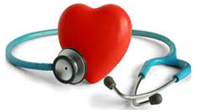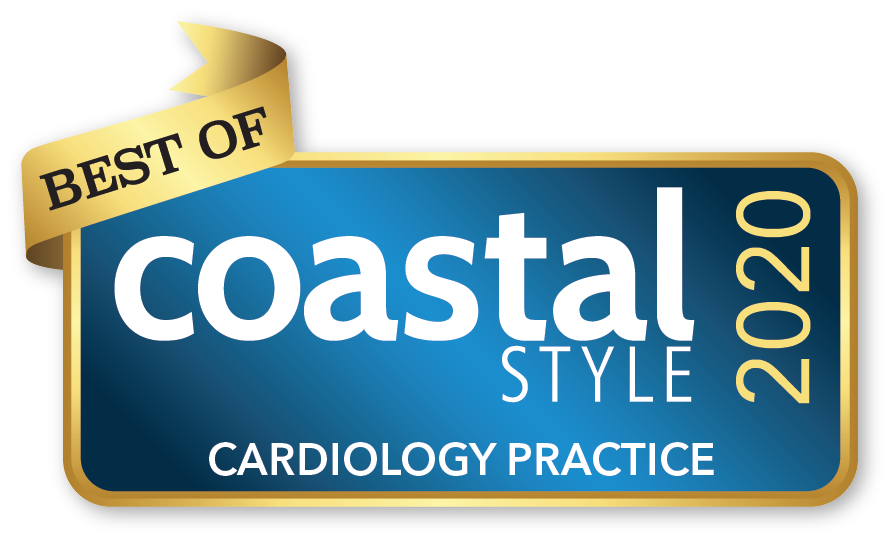Echocardiogram
WHAT IS IT?
Echocardiography is a painless test that uses sound waves to create images of your heart. It provides your doctor with information about the size and shape of your heart and how well your heart's chambers and valves are working.
Basic Facts
Echocardiography is a painless test that uses sound waves to create images of your heart.
This test provides your doctor with information about the size and shape of your heart and how well your heart's chambers and valves are working. In addition, a type of echocardiography called Doppler ultrasound shows how well blood flows through the chambers and valves of your heart.
Your doctor may recommend echocardiography if you're suffering from signs and symptoms that heart problems could cause. The test can be used to confirm a diagnosis, determine the status of an existing problem, or help guide treatment.
There are different types of echocardiography. Transthoracic and stress echocardiography's are standard types of the test. Transesophageal echocardiography (TEE) is used if the standard tests don't produce clear results.
Echocardiography takes place in a doctor's office or hospital. The test usually takes up to 1 hour. A standard echocardiography doesn't require any special preparations or follow-up. If you're having a TEE, you usually shouldn't eat or drink for 8 hours prior to the test.
During a standard echocardiography, the doctor or sonographer will move a wand-like device called a transducer around on your chest to get images of your heart. During a TEE, the transducer will be put down your throat to get a better view of your heart.
A cardiologist will analyze the results from your echocardiography.
You usually can go back to your normal activities immediately after having an echocardiography.
There are no risks associated with transthoracic or fetal echocardiography. If you have TEE, there are some risks associated with the medicine given to help you relax. On rare occasions, the tube used in TEE can cause minor throat injury. The risks for stress echocardiography are related to the exercise or medicine used to raise your heart rate. Serious complications from a stress echocardiography are rare.
Who Needs Echocardiography?
Your doctor may recommend echocardiography if you're suffering from signs and symptoms of heart problems. For example, symptoms such as shortness of breath and swelling in the legs can be due to weakness of the heart (heart failure), which can be seen on an echocardiogram.
Doctors also use echocardiography to provide information on:
The size of your heart. An enlarged heart can be the result of high blood pressure, leaky heart valves, or heart failure.
Heart muscles that are weak and aren't moving (pumping) properly. Weakened areas of heart muscle can be due to damage from a heart attack. Or weakening could mean that the area isn't getting enough blood supply, which can be due to coronary artery disease.
Problems with your heart's valves. Echocardiography can show whether any of the valves of your heart don't open normally or don't form a complete seal when closed.
Abnormalities in the structure of your heart. Echocardiography can detect a variety of heart abnormalities, such as a hole in the septum (the wall that separates the two chambers on the left side of the heart from the two chambers on the right side) and other congenital heart defects (structural problems present at birth).
The aorta. Echocardiography is commonly used to assess and detect problems with the aorta such as aneurysm (abnormal bulge or "ballooning" in the wall of an artery).
Blood clots or tumors. If you have had a stroke, echocardiography might be done to check for blood clots or tumors that may have caused it.
Doctors also use echocardiography to see how well your heart responds to certain heart treatments, such as treatment for heart failure.
Types of Echocardiography
There are several different types of echocardiography-all use sound waves to create images your heart. This is the same technology that allows doctors to see an unborn baby inside a pregnant mother. Unlike x rays and some other tests, echocardiography doesn't involve radiation.
Transthoracic Echocardiography
Transthoracic (tranz-thor-AS-ik) echocardiography is the most common type of echocardiogram test. It's painless and noninvasive. "Noninvasive" means that no surgery is done and no instruments are inserted into your body.
This type of echocardiography involves placing a device called a transducer on your chest that sends special sound waves, called ultrasound, through your chest wall to your heart. Ultrasound waves can't be heard by the human ear. As the ultrasound waves bounce off the structures of your heart, a computer in the echocardiography machine converts them into pictures on a screen.
What to Expect Before Echocardiography
Echocardiography can be performed in a doctor's office or a hospital. No special preparations are needed for most types of echocardiography. Usually you can eat, drink, and take any medicines as you normally would. The exception is if you're having a transesophageal echocardiography. This test usually requires that you don't eat or drink for 8 hours prior to the test.
If you're having a stress echocardiography, there may be special preparations. Your doctor will advise you on how to prepare for your echocardiography test
What To Expect During Echocardiography
Echocardiography is painless and usually takes less than an hour to perform. For some tests, the doctor will need to inject saline or a special dye into your vein that makes your heart show up more clearly on the test images. This special dye is different from the dye used during an angiogram test.
For most types of echocardiography, you will be asked to remove your clothing from the waist up. Women will be given a gown to wear during the procedure. You will lay on your back or left side on an exam table or stretcher.
EKG electrodes will be attached to your chest to allow an EKG to be done. A doctor or sonographer (a person specially trained to do ultrasounds) will apply a gel to your chest that helps the sound waves reach your heart. A wand-like device called a transducer will then be moved around on your chest.
The transducer transmits ultrasound waves into your chest. Echoes from the sound waves will be converted into pictures of your heart on a computer screen. During the test, the lights in the room are dimmed so the computer screen is easier to see.
The sonographer will make several recordings of the images to show different locations in your heart. The recordings will be put on a computer disc or videotape for the cardiologist (a doctor who specializes in treating people who have heart problems) to review.
During the test, you may be asked to change positions or hold your breath for a short time so that the sonographer can get good pictures of your heart. At times, the sonographer may apply a bit of pressure to your chest with the transducer. This pressure can be a little uncomfortable, but it helps the sonographer get the best picture of your heart. You should let him or her know if you feel too uncomfortable.
Echocardiography is similar for fetal echocardiography, except in that test the transducer is placed over the location of the developing baby's heart.
What You May See and Hear During Echocardiography
As the doctor or sonographer moves the transducer around, different views of your heart can be seen on the screen of the echocardiography machine. The structures of the heart will appear as white objects, while any fluid or blood will appear black on the screen.
Doppler ultrasound techniques are often used during echocardiography tests. Doppler ultrasound is a special ultrasound that shows how blood is flowing through the blood vessels. This allows the sonographer to see the blood flowing in different speeds and directions. The speeds and directions appear as different colors moving within the black and white images.
The human ear is unable to hear the sound waves used in echocardiography. If Doppler ultrasound is used, however, you may be able to hear a "whooshing" sound as the echocardiography machine converts the echoes into sounds that can be heard and which the doctor can use as information about the flow of blood through your heart.
What to Expect After Echocardiography
You usually can go back to your normal activities immediately after the test. You may not be able to drive after a transesophageal echocardiography. Your doctor will let you know whether you need to arrange for someone to take you home.
What Does Echocardiography Show?
An echocardiography shows the size, structure, and movement of the different parts of your heart, including the valves, the septum (the wall separating the chambers on the right and left sides of the heart), and the walls of the heart chambers. The Doppler ultrasound technique shows the movement of blood through the heart.
Echocardiography can be used to:
Diagnose heart problems
Guide or determine next steps for treatment
Monitor changes and improvement
Determine the need for additional tests
Echocardiography can detect many different types of heart problems. Some of these can be minor and pose no risk to you. Others can be signs of serious heart disease or other heart problems. An echocardiography can provide information on:
The size of your heart. An enlarged heart can be the result of high blood pressure, leaky heart valves, or heart failure.
Heart muscles that are weak and aren't moving (pumping) properly. Weakened areas of heart muscle can be due to damage from a heart attack. Or weakening could mean that the area isn't getting enough blood supply, which can be due to coronary artery disease.
Problems with your heart's valves. Echocardiography can show whether any of the valves of your heart don't open normally or don't form a complete seal when closed.
Abnormalities in the structure of your heart. Echocardiography can detect a variety of heart abnormalities, such as a hole in the septum (the wall that separates the two chambers on the left side of the heart from the two chambers on the right side) and other congenital heart defects (structural problems present at birth).
The aorta. Echocardiography is commonly used to assess and detect problems with the aorta such as aneurysm (abnormal bulge or "ballooning" in the wall of an artery).
Blood clots or tumors. If you have had a stroke, echocardiography might be done to check for blood clots or tumors that may have caused it.
What Are the Risks of Echocardiography?
There are no risks associated with transthoracic or fetal echocardiography. If you have a transesophageal echocardiography, there are some risks associated with medicine given to help you relax. These include a bad reaction to the medicine, difficulty breathing, or nausea. Your throat also might be sore for a few hours after the test. On rare occasions, the tube can cause a minor throat injury.
There are risks associated with stress echocardiography, but these are related to the exercise or medicine used to raise your heart rate, not to the echocardiography part of the test. Serious complications from cardiac stress tests are very uncommon.
Website by: Coastalimagesinc.com for Beach-net.com




